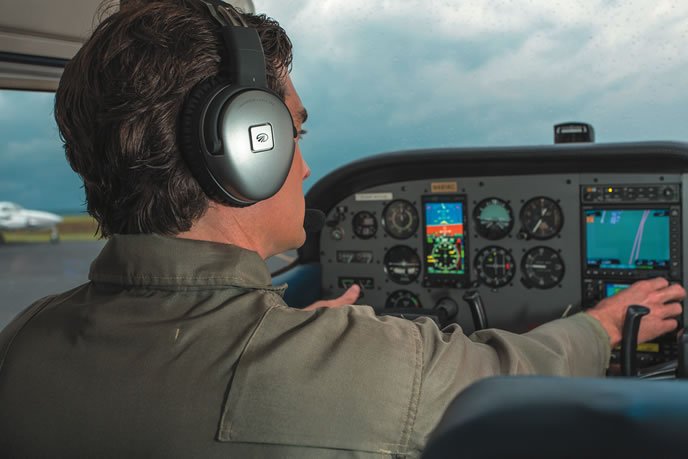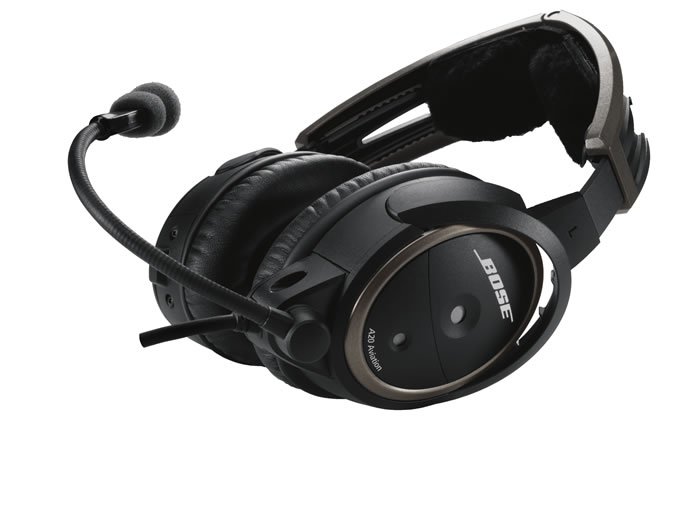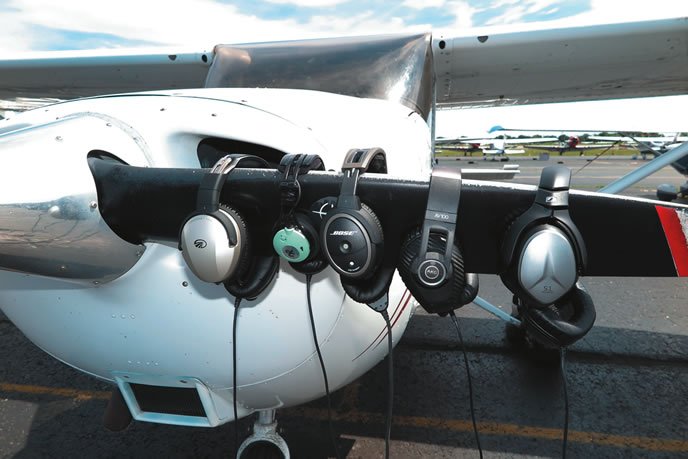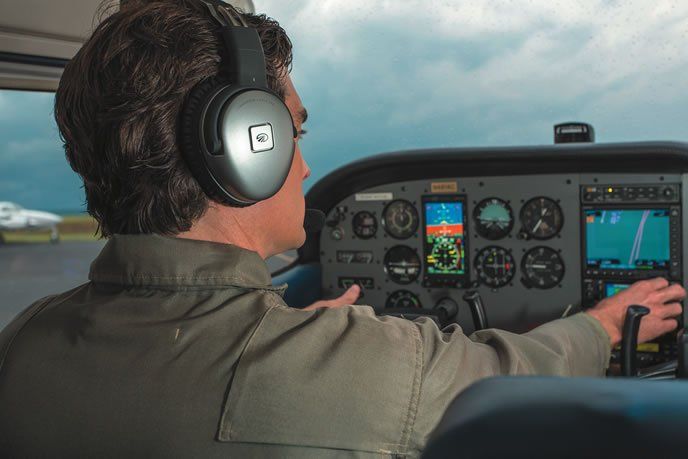For buyers willing to drop as much as $1100 for an aviation headset, the current market has no shortage of choices. Moreover, models in this high end of the market sport more advanced features than ever, while promising the best sound quality, comfort and build quality money can buy.

To subjectively determine which model takes the top spot (not an easy task, considering the personal nature of selecting a headset), we spent the better part of a year flying with four models we think represent the best of the best. While our evaluation turned up an overall favorite, each model has its strengths and weaknesses and our takeaway is it’s hard to make a wrong choice.
The ones that made the top four got there based on our previous independent evaluations. They include Lightspeed’s Zulu PFX, the updated Bose A20, Harmon’s AKG AV100 and David Clark’s on-ear DC Pro-X.
How we evaluated
We flew with them, of course, in a variety of aircraft (piston singles, twins and a turboprop) and with different audio systems. As we’ve done with previous headset reviews, we handed them out to a diverse group of pilots for their feedback. Eyeglasses, ballcaps, earings, small heads, big heads and big hair were all considerations. We also plugged each one of the headsets into an avionics test bench to evaluate microphone modulation quality.

No, we didn’t send the headsets through an audio lab. While we’ve done this in the past, we don’t think raw specs alone are as critical as real-world performance in a variety of aircraft cabins on a variety of heads.
What is critical is fit and finish, Bluetooth performance, music quality, ease of operating the ANR control module and feature set, plus the headsets’ ability to sustain abuse on a day-to-day basic. We weren’t gentle.
What might you expect from a headset that cracks the $1000 price point? A carry case, of course, and all four come equipped. They also all come with straight interface cords, universally adjustable boom microphones and batteries. There is an option to bypass batteries and plug them in to ship’s power through a LEMO or Redel plug. But to do that, you’ll pay a shop to install an interface jack. We did. This can be a hefty invoice, so get a quote first.

In our trials, each headset was evaluated with its noise canceling on and off, receiving typical radio transmissions and ATIS briefings, and with music streamed in through the audio panel as we’ll as through the onboard Bluetooth when applicable. iPhones 5S and 6+ were used for Bluetooth. Headset comfort and performance was evaluated both with and without eyeglasses.
Evaluation criteria included the noise level with ANR both on and off. The quality of radio transmissions, panel-provided music and Bluetooth music was compared directly. To determine ease of use, all headsets were used without first reading the manual, for example, to see if the Bluetooth pairing process was intuitive. All audio panel radio and music comparisons were made with the headset volume controls at maximum and no adjustments made to the panel volume controls or music input volume. Bluetooth volume controls were made at the maximum volume of the iPhone. Let’s look at each model.
bose a20
This past July, Bose released an update to its five-year-old A20, which adds much-needed music Bluetooth features to the set’s stellar ANR performance. Worth noting is the A20 came out on top in previous Aviation Consumer reviews, but we’ve been dinging it of late for lack of modern Bluetooth features. A new field-replaceable cable/ANR module assembly changes all of that for the better, enabling Bluetooth music capability and the ability to prioritize multiple wireless sources. We covered this update in the September 2015 issue of Aviation Consumer and liked it.
While the quality of the A20’s music when sourced through the audio panel is quite good, it’s not the best in the group, in our view. However, if it were not for side-by-side comparisons with music sent into PS Engineering’s Bluetooth audio panel we might not have questioned it at all.
But to our ears, music sent directly into the headset via Bluetooth resulted in excellent base response and is greatly improved compared to the quality of the wired intercom music. See the sidebar on page 10 for more on cabin music quality and wiring.
When the A20’s ANR circuitry is off (passive), the A20 was among the worst in the roundup—even the on-ear David Clark edged it out. That’s cause for keeping fresh batteries on hand or plugging the set into ship’s power. Additionally, when eyeglasses are worn, several evaluators complained of deteriorated noise reduction, noting a fair amount of high-frequency hiss, much like the over-ear David Clark model.
As for comfort, we think the A20 is quite good, but perhaps not the best. The headband has an unusual springed hinge which due to this design, seems to put slightly higher inward forces on the ears and downward forces on the head. Still, some users may find other headsets more comfortable, or the Bose the most comfortable. Still, the ear cushions are the least thick of all the headsets reviewed, but we don’t think this affects overall comfort. Minor nits: Auto-power-on/off and Bluetooth/intercom priority and the stereo/mono controls are tucked away behind the batteries.
Compared to the previous Bose A20, the revised $1095 A20 ($995 without Bluetooth) adds Bluetooth music, auto-power on, a revised mic with slightly longer boom and more control over audio priorities. ANR performance seems to be unchanged. A field upgrade for existing A20s costs $295. It includes an aux music cable and is available in six versions, including models with coiled cords, helicopter plugs and even an Airbus plug. The ergonomics of the control box are identical, although functions have slightly changed and some buttons have become a more visible gray. We like that music can be auto-muted or can be set to play over panel audio.
harmon AKG AV100
We reviewed the $1099 AKG AV100 headset in our June 2014 issue. A head-to-head evaluation now reveals that this Harmon Kardon-produced headset has excellent audio quality, decent ANR performance and is also the most comfortable, in our view.
It came with a number of extras that no other brand included. For instance, it comes standard with a LEMO plug and an adapter to the standard dual-plug adapter, which Bose sells as a $60 option. The headset comes with a pair of white map light LEDs pointed down and forward from the earcups, which could be convenient for reading checklists or charts at night. There are verbal prompts about the status of the Bluetooth interface. Finally, the control box offers a dedicated play/pause button to control music via Bluetooth.
The AKG’s earcups are the most distinctive in the group, being almost V-shaped and also the most padded in the roundup. The downside is ANR performance. With eyeglasses, the AV100 offered the worst ANR performance, but evaluators raved at the set’s overall comfort. For easier storage, the earcups twist flat.
The AKG really shines in audio quality with excellent music fidelity. Subjectively, the clarity and volume were fantastic, both via Bluetooth and panel-input music, although the PFX offers more customizations. The same observations were made of radio traffic, although it was mostly a higher volume that was noticeable. Oddly, the Bluetooth volume control box does not remotely control the iPhone volume when listening to music (although it does adjust the volume internally), but it does remotely control the volume when using the phone. We did experience infrequent fraction-of-a-second drop-outs of the audio in Bluetooth music mode, but not reliably repeatable.
Perhaps the first thing many users will notice is the length of the AV100’s microphone boom. It’s a half inch longer than the others and an inch longer than the one on the previous Bose A20. Turns out this is a good thing, especially since it’s easier to flex, plus it clearly indicates which side to speak into. It can be attached to either earcup, the cord is slimmer, lighter and more flexible than the others, but it only comes with one cord clip—making it a challenge to neatly stow in smaller cabins.
As for ANR performance, the AV100 consistently fell short. Evaluators noted that it wasn’t as good as the Bose, noting a high frequency hiss. In the twin, an early model of the AV100 revealed some ANR flaws when the propellers were out of sync, but a replacement headset solved the problem. With the ANR circuitry turned off, the AV100 did well. Speaking of ANR power, we like that the set turns on when power is applied, as does the Bose.
lightspeed zulu pfx
Lightspeed’s $1100 PFX is the newest model in this roundup (we reviewed it in the July 2014 issue of Aviation Consumer). Available in dual-plug, LEMO and helicopter models, this headset is the only one which has software control modes for each interface. It also comes with a USB cable for updates.
The PFX is the most advanced headset in this roundup and in our view is the king of features. Indeed, there are so many features that some can only be accessed by a free companion phone app called FlightLink.
Additionally, the headset’s features can be updated by connecting the control box to a Mac or PC and downloading new firmware; a recent firmware update earlier this year increased battery life, added a new “save” feature and fixed unspecified bugs.
The PFX’s claim to fame is its flexible CPU and configurable ANR circuitry. Dubbed “Streaming Quiet,” the headset is constantly monitoring the sound environment and making periodic changes to the ANR performance. In addition, the headset performs acoustic response mapping by playing calibrated sounds into the earcups to adjust its noise reduction and audio equalization to your particular head. The iOS app allows separate settings of bass and treble for both intercom and Bluetooth music inputs, while a feature called “Front Row Center” attempts to make music sound three-dimensional, while “Voice Clarity” attempts to make the intercom modulation more intelligible. The app can also record and playback headset audio over a Bluetooth connection.
With all of this technology, it should come as no surprise that the PFX has excellent music quality, in our view. Out of the box, it isn’t as good as the Harmon AKG, but it can be tuned to taste. Surprisingly, the ANR performance is, in our estimation, on par with the Bose A20 rather than clearly leading the pack with all of that advanced software. Headset comfort was good, but not as good as the AKG and similar again to the Bose, although the other headsets may have a slightly better fit over the ears, depending on the shape and size of those ears.
The PFX has several warts, however. It uses four AA batteries instead of the usual two, and only gets roughly 20 hours out of them—less when streaming Bluetooth music. Our other nit is the size of its control module. It’s huge and has both cords on one side of it, making it a bit harder to find a place to stow. In some aircraft we tried, the module wouldn’t even fit in a map pocket.
The set’s ANR performance is extremely sensitive to how the headset sits on the head, and slight adjustments can make large differences in noise reduction, which could be problematic if you are a frequent head mover. But as we’ve noted in the previous review, we like that software patches can help improve the sets performance, moving forward.
Incidentally, we were able to improve the ANR performance of a PFX by swapping the headpad with a taller one provided by Lightspeed at no charge. On some heads, the thinner pad doesn’t offer enough downward adjustment of the slider to place the earcups entirely over the critical area on the side of the head. The simple swap of the headpad brought the PFX’s ANR quality to a level that matched the Bose A20.
david clark pro-x/p
The $637 DC Pro-X is the least expensive model in the roundup, but it made our top-four favorite because of its performance, comfort and overall value.
Not only is it the lightest at only 7.5 ounces—almost half the weight of the PFX—it was also the only on-ear headset. By that we mean its cushioned ear seal sits directly on—rather than around—the ear. The Pro-X and Pro-XP models differ solely by connector: a dual-plug or a LEMO plug, respectively. Their performance is identical.
The Pro-X shines in comfort. The headset is 7.5 ounces and the clamping forces are low. The ear cushions are quite wide with a small hole in the center for sound and ANR. Due to this design, there is almost no difference in noise levels or sound quality when wearing glasses. There is still a little pressure on the head from wearing glasses, but it is now located under the ear where eyeglass temples usually bend down. Because the earcups are circular, the headband can be tilted backward and forward through its entire range, and the earcups also swivel. In short, positioning on the head is more important for this headset than the others, but the reward is that this model could be the most comfortable of the bunch.
The ANR performance of the Pro-X is modest. While we don’t think it matches the others in the roundup, it’s still competent. The DC actually has quite good low-frequency ANR signatures and its midrange ANR is comparable to the Bose. Due to the complex shape of human ears, it is probably not possible to match the total noise reduction of the over-ear headsets, but the DC nonetheless holds its own reasonably well. Surprisingly, when the ANR circuitry was turned off, the DC was among the better performers when passive.
The Pro-X has the simplest control box of the group, with just three controls: power, Bluetooth and stereo volume. Auto-off and stereo/mono controls are provided in the battery case. The volume is digital and does not work when power is off. This only adjusts the panel input volume; Bluetooth volume for both music and phone calls is adjusted using only the connected device.
Uniquely, there is no auxiliary audio input jack available. The two LEDs on the control box are multi-colored and gently pulse on and off.
The music quality is adequate. Compared to the rest of the bunch, it is more tinny, with less bass and treble. This was not consistent, as sometimes it felt like it had better bass response than the Bose.
This leads to a hypothesis that audio quality might be very sensitive to the location of the earpiece. Surprisingly, when listening to music from the PM8000C audio panel, the sound quality was better when the DC’s ANR circuitry was turned off. Music volume, however, is good. Aircraft radio audio also had this tinny quality to it, and with ANR off the radio volume was particularly low and would need to be adjusted on the panel. To be fair, this was the case with all the headsets, but it was particularly marked for the DC.
The Pro-X folds up quite small for easy traveling, plus DC provides a trademark green cable tie for cord management. A longer cord would be welcome. The mic boom swivels a full 270 degrees for use on either side of the head. It’s not entirely clear which side of the microphone to speak into with the provided wind muff attached, but this should only be an issue while getting acquainted with the headset. David Clark claims a 50 hour battery life—the longest lasting in our roundup.
roundup wrap-up
As you can probably tell, it’s hard to pick an overall winner because all of these high-end headsets have some strengths and some weaknesses. Further, none of these shortcomings are fatal and it is possible to make some general recommendations.
After a year of living with all four headsets, sharing them with passengers and other pilots and randomly comparing them back-to-back, the Bose A20 always seems to be a favorite. Its new auto-on and Bluetooth music features make it even easier to favor. Its five-year-old ANR still seems to be the best (although in some aircraft the PFX matches it) and the audio quality and light weight are such that even five-plus-hour flights prove comfortable and unfatiguing. Its recent update brings it to a feature parity with the other headsets and the easy upgrade saves $800 over buying a new headset.
The Lightspeed PFX is a top contender. It has the most features, excellent sound quality and solid ANR, plus it can be upgraded over time to keep up with the latest technology trends. On the downside, it is sensitive to how the headset is worn, has an inconveniently large control module and eats batteries four to five times faster than the others.
For the pilot seeking the best comfort and music quality, we think the AKG AV100 wins, but its ANR performance—although good—doesn’t match the Bose.
For sheer lightness and comfort, the David Clark Pro-X can’t be beat. Users who don’t like full-ear enclosure headsets will find this an excellent option. It has the smallest travel size and better, the smallest price tag.
In the end, we think it comes down to personal preference, so we recommend trying one or more of these out before you part with your one grand. Fortunately, there’s almost no wrong choice to be made.





